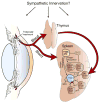Immune escape mechanisms of intraocular tumors
- PMID: 19563908
- PMCID: PMC2727063
- DOI: 10.1016/j.preteyeres.2009.06.002
Immune escape mechanisms of intraocular tumors
Abstract
The notion that the immune system might control the growth of tumors was suggested over 100 years ago by the eminent microbiologist Paul Ehrlich. This concept was refined and expanded by Burnet and Thomas 50 years later with their articulation of the "immune surveillance" hypothesis. In its simplest form, the immune surveillance hypothesis suggests that neoplasms arise spontaneously and express novel antigens that are recognized by the immune system, which either eliminates the tumors or restrains their growth. Within the eye, immune responses are controlled and sometimes profoundly inhibited - a condition known as immune privilege. Immune privilege in the eye is the result of a complex array of anatomical, physiological, and immunoregulatory mechanisms that prevent the induction and expression of many immune responses. Tumors arising in the eye would seem to have an advantage in evading immune surveillance due to ocular immune privilege. Uveal melanoma, the most common and malignant intraocular tumor in adults, not only benefits from the immune privilege of the eye but also has adopted many of the mechanisms that contribute to ocular immune privilege as a strategy for protecting uveal melanoma cells once they leave the sanctuary of the eye and are disseminated systemically in the form of metastases. Although the immune system possesses a battery of effector mechanisms designed to rid the body of neoplasms, tumors are capable of rapidly evolving and countering even the most sophisticated immunological effector mechanisms. To date, tumors seem to be winning this arms race, but an increased understanding of these mechanisms should provide insights for designing immunotherapy that was envisioned over half a century ago, but has failed to materialize to date.
Figures






Similar articles
-
Immunology of intraocular tumors.Ocul Immunol Inflamm. 2005 Feb;13(1):105-10. doi: 10.1080/09273940490518586. Ocul Immunol Inflamm. 2005. PMID: 15835077 Review.
-
Ocular immune privilege and ocular melanoma: parallel universes or immunological plagiarism?Front Immunol. 2012 Jun 13;3:148. doi: 10.3389/fimmu.2012.00148. eCollection 2012. Front Immunol. 2012. PMID: 22707951 Free PMC article.
-
Influence of immune surveillance and immune privilege on formation of intraocular tumors.Chem Immunol Allergy. 2007;92:276-289. doi: 10.1159/000099278. Chem Immunol Allergy. 2007. PMID: 17264503 Review.
-
Influence of immune privilege on ocular tumor development.Ocul Immunol Inflamm. 2010 Apr;18(2):80-90. doi: 10.3109/09273941003669950. Ocul Immunol Inflamm. 2010. PMID: 20370332 Free PMC article. Review.
-
Requirement of CD80+ costimulation for rejection of ocular tumors and termination of immune privilege.Exp Eye Res. 2006 Sep;83(3):574-83. doi: 10.1016/j.exer.2006.02.009. Epub 2006 Apr 27. Exp Eye Res. 2006. PMID: 16643898
Cited by
-
Recent Advances and Challenges in Uveal Melanoma Immunotherapy.Cancers (Basel). 2022 Jun 23;14(13):3094. doi: 10.3390/cancers14133094. Cancers (Basel). 2022. PMID: 35804863 Free PMC article. Review.
-
LAG3 and Its Ligands Show Increased Expression in High-Risk Uveal Melanoma.Cancers (Basel). 2021 Sep 3;13(17):4445. doi: 10.3390/cancers13174445. Cancers (Basel). 2021. PMID: 34503258 Free PMC article.
-
CTL induction of tumoricidal nitric oxide production by intratumoral macrophages is critical for tumor elimination.J Immunol. 2010 Dec 1;185(11):6706-18. doi: 10.4049/jimmunol.0903411. Epub 2010 Nov 1. J Immunol. 2010. PMID: 21041723 Free PMC article.
-
Retinal Inflammation, Cell Death and Inherited Retinal Dystrophies.Int J Mol Sci. 2021 Feb 20;22(4):2096. doi: 10.3390/ijms22042096. Int J Mol Sci. 2021. PMID: 33672611 Free PMC article. Review.
-
Immunotherapy for ocular melanoma: a bibliometric and visualization analysis from 1991 to 2022.Front Oncol. 2023 May 31;13:1161759. doi: 10.3389/fonc.2023.1161759. eCollection 2023. Front Oncol. 2023. PMID: 37324010 Free PMC article.
References
-
- Abi-Hanna D, Wakefield D, et al. HLA antigens in ocular tissues. I. In vivo expression in human eyes. Transplantation. 1988;45:610–613. - PubMed
-
- Agata Y, Kawasaki A, et al. Expression of the PD-1 antigen on the surface of stimulated mouse T and B lymphocytes. Int Immunol. 1996;8:765–772. - PubMed
-
- Albert DM. The ocular melanoma story. LIII Edward Jackson Memorial Lecture: Part II. Am J Ophthalmol. 1997;123:729–741. - PubMed
-
- Alexander AM, Crawford M, et al. Indoleamine 2,3-dioxygenase expression in transplanted NOD Islets prolongs graft survival after adoptive transfer of diabetogenic splenocytes. Diabetes. 2002;51:356–365. - PubMed
-
- Algarra I, Cabrera T, et al. The HLA crossroad in tumor immunology. Hum Immunol. 2000;61:65–73. - PubMed
Publication types
MeSH terms
Grants and funding
LinkOut - more resources
Full Text Sources
Other Literature Sources
Medical

